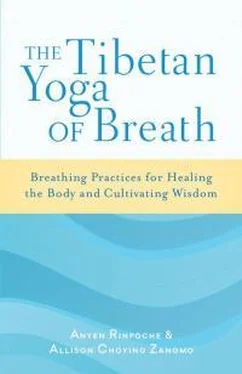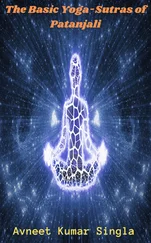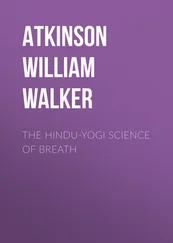Even though we may not be at the level of these ancient lamas, we can use Tonglen as a healing practice. When experiencing great physical or emotional pain, it is taught that if we focus on the pain of others, our own pain level will actually decrease. As we breathe in, we can think, “May I take on all the pain of others who are hurting as much as I am,” and then as we breathe out, think, “May all living beings enjoy peace, happiness, and health.” No matter what kind of suffering we face, whether we are sitting on the cushion, whether it be in our daily lives, whether it is fabricated by the mind, whether it is actually happening, whether that suffering is great or large—using the technique of Tonglen allows us to be victorious over suffering.
If we are ill, or when we have received a medical diagnosis we must contend with, we can use the practice of Tonglen in a slightly different way. Let’s take the example of suffering from cancer. We know that beings all over the world are suffering from cancer in a similar manner as we may be. As we breathe out, we visualize the breath as dirty, heavy, black soot. We breathe out the impurity of that illness. As we do so, we think, “May I dispel the illness of all beings who are suffering just like me.” Then, as we breathe in, we see the breath as pure clear light, and think, “Based on taking in the vitality of the five elements, may my own illness and that of everyone who is suffering just like me be healed.” We can imagine the vitality of the five elements as clear light covering our entire body, inside and out, and also penetrating the bodies of beings all over the world. We may not be at the level of realization where we are able to cure ourselves, or have the ability to cure others, but we can still use this practice to develop our love, compassion, and sense of connection with others. And, from the point of view of the Tibetan tradition, it is possible that such practices can cause the progression of illness to slow or recede, and for some at least some healing can occur—even for a novice practitioner.
EVERYDAY ENGAGED PRACTICE
Difficult situations, large and small, are arising at every moment. Try this: make a list of all of the opportunities you would have had to work with wind energy training today had you remembered to notice the reaction in your mind and turn your awareness back to your breathing pattern. Your list might look something like this:
1. Woke up feeling discouraged about another day of hard work at the office
2. Felt impatient with my husband, who did not put the dishes away the night before
3. Frustrated by traffic on the way to work
4. Person in front of me drove too slowly
5. Sun blinded me as I was driving
6. At work, too much stacked on my desk
7. Supervisor criticized project from last week
8. Someone made the coffee too strong
9. Coworker not pulling his share of the load
10. Mom called, upset about Aunt Jane in the hospital
11. Got a paper cut
12. Supervisor snapped at me
13. Office finances are stressed, high stress in the office
And so on. . . .
This may help us to actually see how many difficult situations we experience during the day! We can use our list to cultivate more awareness of our state of mind and of how we breathe. We might choose just one situation from our list and focus on that for a week or two. For example, if we choose “getting irritated while driving,” we could choose the times when we are driving in the car each day to cultivate more awareness of our mental state and also of our respiratory pattern. After we start to notice ourselves having more awareness while we drive, we can make a new list, and choose a new situation to work with.
Conclusion
Breath Is Wisdom
IN THIS BOOK we have reflected on and worked at length with the many expressions of the ordinary wind-mind. We have understood it to contribute to physical illnesses through depriving our blood, brain, and organs of oxygen and carbon dioxide when we breathe thoracically. We have understood it to be an expression of neurosis: of the ordinary mind’s emotional responses and habits. We have understood it to be an expression of nying lung: Tibetan medicine’s way of describing the extreme buildup of energy in the chest that fuels cardiopulmonary disorders and erratic or strong emotions and behavior. We have also understood it is a contributing factor to stress, which can further develop into anxiety and depression, or exacerbate our physical ailments. However, we have also understood the wind-mind as something that can be trained and something that can be purified. By training and purifying the wind-mind, the natural wisdom dwelling inside of us as Buddha Nature begins to shine through.
It takes a leap of faith to believe that spiritual realization is possible. Many of us lack the confidence and self-esteem it takes to believe that we are capable of expressing such qualities as selflessness, altruism, and wisdom. Wind energy training can help us change this ingrained way of thinking. Through this practice, making small changes in our lives helps us build the confidence that larger changes are possible. Step by step, we are capable of transformation! Even if we do not believe in the idea of spiritual enlightenment, we can use our powers of intellect, logic, and reason to accept the idea that all the impurity of body and mind can be purified.
Purification of karma and the mind’s ordinary tendencies and reactions are the keys to this practice. Throughout this book, we have reflected on how wind energy training, and retraining ourselves to breathe abdominally, helps us to change our habitual, unhealthy reactions and habits of body and mind. Having understood the way in which the breath, the wind energy, is an underlying cause of so many physical and mental imbalances, we have the capability, right here and now, to stop this cycle. By purifying the patterns of impure wind energy that rise up in the body, we actually change our deeply ingrained physical, mental, and emotional patterns.
Wind energy training is such an easy and powerful practice that it is accessible to everyone—if only for the simple reason that we must breathe to stay alive. Take a moment to call to mind all the support we have for spiritual development. We often focus on how our life circumstances are difficult and painful. We forget all the supportive conditions we have to help us on our spiritual journey. For example, we are extremely fortunate in that we know how to speak and use language. As a result, when we are given instructions on how to practice the spiritual path, we have the ability to put them into practice. Also, for most of us, our basic subsistence needs are fulfilled. As a result, we have the physical and mental energy, as well as time, to focus on spiritual practice.
Practicing the wind energy trainings offered in this book may be our very first encounter with breath yoga. But we don’t have to be an experienced yogi to benefit from the teachings in this book. All of us are equally capable of working with the inhalation and exhalation of the breath. After the lessons and insights of this book, we may see the practice of breath work as a wish-fulfilling gem that we never knew we carried until now.
This wish-fulfilling gem eradicates our suffering the more we practice. It staves off physical and mental illnesses. It cultivates emotional stability. On a daily basis, it can bring us greater peace of mind because we carry the breath with us wherever we go. No matter what is happening in the moment, we need not disengage from life for a second to “practice.” We simply need to remember to practice breathing!
Because wind energy training is such an easy practice to take up and because the results are so beneficial—immediately and long-term—there is no excuse for putting it off. The instructions on how to purify impure wind energy are more valuable than gold. They can completely transform our cyclic, habitual patterns of suffering. Wind energy training represents complete abundance in our lives. There is no shortage of anything—we have all the support and opportunity we need to practice. The only thing that stands in our way is us—and whether or not we choose to step onto the spiritual path.
Читать дальше












